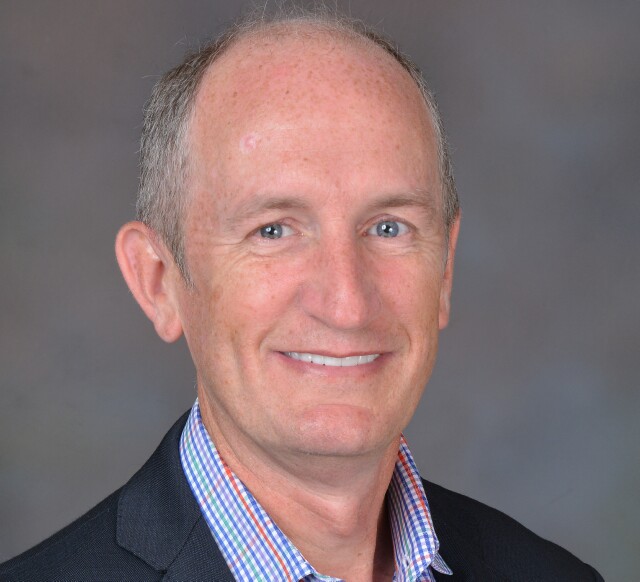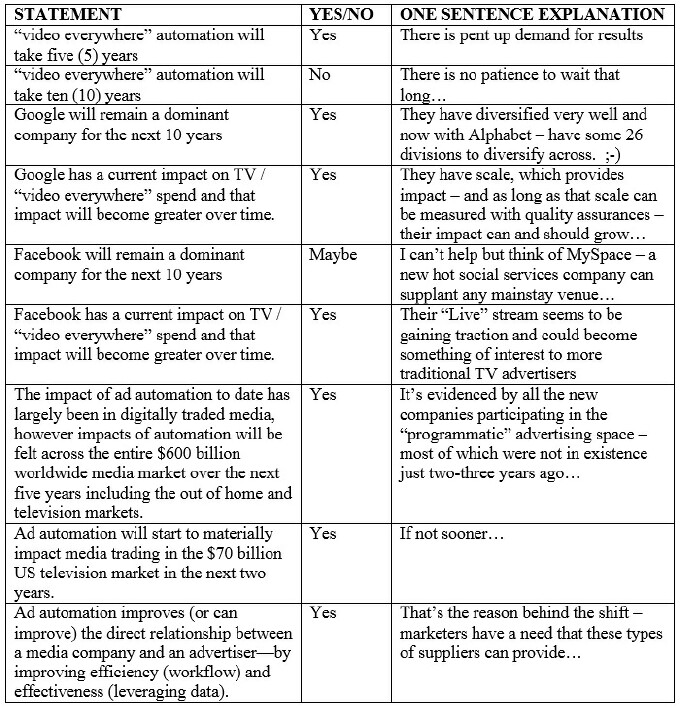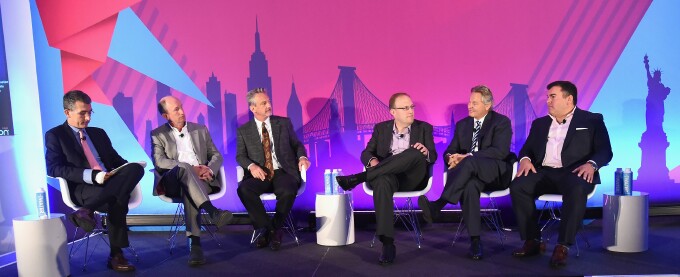Brendan Condon of AdMore on Video Everywhere and Automation

Jay Sears, Senior Vice President at Rubicon Project, recently spoke with Brendan Condon, President and CEO of AdMore, about Video Everywhere. The two appeared at a program on the topic at Advertising Week in New York City in September. You can view a video of the program here.
(The Video Everywhere program at Advertising Week New York. Pictured left to right: Jay Sears; Brendan Condon; Scott Stansfield of Centriply; Scott Wells of Clear Channel Outdoor; John Partilla of Screenvision, and Michael Strober of Turner Broadcasting. Click on the links to read Jay’s interviews with them.)
JAY SEARS: What do you read to keep up with politics, art and culture?
BRENDAN CONDON: New York Times, Wall Street Journal, Vanity Fair, Time, Entertainment Weekly
SEARS: What do you read to keep up with friends?
CONDON: Same as above, and select novels from best seller lists.
SEARS: What do you read to keep up with the media and advertising technology industries?
CONDON: Wall Street Journal, Business Insider, AdAge, AdWeek, Broadcasting & Cable, MultiChannel News
SEARS: What’s your favorite commercial of all time?
CONDON: The Your Point of View HSBC print campaigns, shown at airport jet bridges and corridors.
SEARS: When you speak about “video everywhere” ad automation (including TV, out of home and cinema) how widely or narrowly do you define this?
CONDON: For AdMore “video everywhere” means everywhere and whenever you watch linear television. Regardless of daypart, geography, program or content type, we target you for our national marketing partners that are looking to find you -- similar to a private detective.
SEARS: With regards to advertising automation impacting “video everywhere,” what are the three biggest trends you expect to impact companies in 2016 and 2017?
CONDON:
- Hyper Targeting – which is here – but it will be more so in scale.
- Optimizing ad campaigns with counter-programming selections to tent-pole events -- “rainmaking” for advertiser agencies.
- Simul-delivery of ads across multiple screens with common measurements of viewership and potential for sequential ad creatives.
SEARS: With regards to advertising automation impacting “video everywhere,” what are the three most overblown topics that you wish would just go away?
CONDON:
- “Programmatic.” When the term goes away and it becomes a common course of doing business rather than being called out as something unique.
- Same as above.
- Same as above.
SEARS: Describe your company or division and then tell us the top three opportunities you are working on to advance “video everywhere.”
CONDON: We are one of the country’s largest TV advertising networks that enables national brand marketers to reach targetable viewing audiences in scale. The AdMore platform reaches over 111M TV households across 200 DMAs with its 1200+ television partners spanning national cable networks, MPVDs, national broadcasters and locally owned and operated TV stations. The company offers full transparency for measuring a campaign’s performance with its web-based dashboards and twice daily feeds of Nielsen-monitored reporting.
The top three opportunities are:
- Partnering with DSPs and DMPs in an effort to help expand their digital and mobile offerings to include linear TV as a comparable and efficient medium;
- Co-authoring white papers with GABBCON for more effective adoption of standardizations across API integrations;
- Working closely with agency trading desks to help brands with true(r) cross-platform optimization, automated campaign delivery and transparent measurement of viewing audiences.

SEARS: Will Nielsen (and Geopath FKA TAB for OOH) remain the standard for media currency? Will the innovations be primarily in audience definition and measurement, with these innovations being “translated back” to Nielsen as the currency?
CONDON:We are primarily a Nielsen shop and often refer to it as the “Bronze Standard” – it’s not ideal but it works. Improvements in the timeliness of their reporting and the increased depth and breadth of Nielsen’s viewing audience monitoring and resulting measurements will be the key to their continued leadership position. As Nielsen continues to expand into digital data collection and analysis (e.g. purchasing Exelate was a brilliant move) they will improve upon their analytic capabilities and offerings made available across the growing digital and linear media consumers of their data.
SEARS: Do we live in a “tale of two cities” where Google and Facebook win almost everything, advertisers are dictated to and other media companies fight for the scraps? What do you expect the impact of Google and Facebook to be in “video everywhere”/TV?
CONDON: Marketers and agencies want options, and while Google and FB may provide scale they will always have the stigma of who they are -- behemoths that have too much leverage over your data and insights, with a good chance of disintermediating you with your clients in the long-term. In turn, there will always be opportunities for other media outlets to succeed provided they come to the table with valuable and unique solutions and provide those in scale. There is an enormous amount of proliferation in this space today; the ones that can separate themselves with quality results and transparency around their methodologies and sources will win.
SEARS: Transparency -- on media costs, on data, on inventory -- continues to be a lightning rod issue. Should transparency be a negotiated benefit for the advertiser client, yes or no?
CONDON:Transparency is a two-edged sword. I am a big fan of sharing source data and media usage, but I don’t believe we need to share economics. If the campaign is being delivered as stated in an IO or as indicated in a presentation -- with readily available proof and assurances of quality control and accuracy in measurement -- then who cares if the provider is making money (or not)? Many businesses operate under unique financial constraints and investment practices, and those do not need to be shared in an effort to be transparent on how one reaches a target audience. They are two separate practices.
SEARS: Please answer the following statements yes or no.
CONDON:

SEARS: If you had your own TV talk show, what would you name it?
CONDON:Everyday Questions -- it’s a chance for people to hear about the everyday lives of celebrities, like what car they drive, where they shop, what they do on date nights, etc. A nice chance for product placement!
SEARS: A young family member has come to you seeking career advice. They must choose one of the following careers: ad agency executive, media company executive, ad technology executive or company marketing executive. Which career path do you recommend and why?
CONDON: Depends on their interests and capabilities. So many of these firms or sectors are so similar today that it’s hard to distinguish. I always recommend they look for places that foster a culture for learning and advancement. The financial rewards will come in time. They should be sure to meet with their new boss, not just a hiring manager. They could otherwise get lost in a shuffle, especially with some of the larger media and ad tech firms.
SEARS: What is your favorite restaurant in the world?
CONDON: Home! I get to eat what I want when I want -- and have the best companion diners in my family.
SEARS: Thanks, Brendan!
Click the social buttons above or below to share this content with your friends and colleagues.
The opinions and points of view expressed in this article are exclusively the views of the author and/or subject(s) and do not necessarily represent the views of MediaVillage.com/MyersBizNet, Inc. management or associated bloggers.



